Day of military glory of Russia. The destruction of the Swedish squadron in the Battle of Gangut
This victory was the first major military success of the Russian fleet in the Baltic and had great military-political significance. Tsar Peter I himself equated it in importance to the Battle of Poltava. After all, the newly built Baltic Fleet defeated the strongest Swedish fleet in the Baltic at that time, which before the Battle of Gangut did not know defeats. The Russian galley fleet was opened the way to the Gulf of Bothnia, and therefore to Stockholm, the Swedish capital. The Swedes were demoralized and took the ships to Stockholm, the fleet was given the task of covering up the Swedish capital and lost the opportunity to actively interfere with the actions of the Russian army in the coastal zone. The Swedes took emergency measures to strengthen coastal defense. Thus, this military success significantly strengthened the position of the Russian troops in Finland and created the conditions for the transfer of hostilities to the territory of Sweden itself.
prehistory
In 1700, Russia, in alliance with Denmark and the Polish-Lithuanian Commonwealth, entered the war against the Swedish empire, in order to recapture the old Russian lands in the Baltic States, to strengthen the military-strategic position in the north-west of the Russian state and to have the opportunity to expand economic contacts with Europe through the Baltic. In the early years of the war, the Russian army was able to break through the corridor to the Baltic, having beaten off such old Russian fortresses as Oreshek (Noteburg), Nevsky town (Nyenskans), Yuriev-Derpt, Ivangorod. Our troops occupied the mouth of the Neva and Tsar Peter founded the new city and the port of St. Petersburg, which was strongly fortified from the sea. At the same time, the process of creating the Baltic Fleet was proceeding at an accelerated pace.
In 1709, in a decisive battle, the Russian army crushed and captivated the victorious Swedish army of Charles XII. Victory at Poltava made it possible to consolidate the successes of the Russian weapons on the shores of the Gulf of Finland and challenge the sea power of the Swedish Empire in the expanses of the Baltic Sea. Peter made the final decision on the transfer of the capital to St. Petersburg. Large units of the Russian army, preparing to defend the internal areas of the Russian state from the Swedish invasion (Karl XII planned an invasion with the aim of seizing Moscow), were transferred to the Baltic direction. It was necessary to oust the Swedish troops from the coast of the Gulf of Finland and Riga.
After that, the Russian troops began to consistently crush the Swedish troops: almost all of the Baltic states were captured, including Riga, Revel and Vyborg. Vyborg campaign of the Baltic Fleet was a great lesson for personnel. The Baltic Fleet received good bases in the Baltic. However, Russia faced the problem of a powerful Swedish fleet. Despite the decisive defeats on land, the loss of major territories and defensive lines, economic collapse, the Swedish government persisted and continued the war, hoping to use the fleet to contain Russian forces and wait for a strategic turnaround in the war (the Swedes hoped to enter the war against Russia Turkey and England ). However, England was in no hurry to openly intervene in the war, and Turkey conducted only a short-term campaign. After the failure of the Prut campaign (1711), Tsar Peter Alekseevich, at the cost of abandoning Azov, managed to make peace with Porta. This allowed again to concentrate all forces in the fight against the Swedish Empire and to resume active hostilities in the Baltic Sea. In addition, Russia began to help the allies (Denmark and Saxony) and was involved in the war in Pomerania (the Baltic lands in Germany). This has prolonged the war.
In the 1713 campaign of the year, Russian troops took Swedish strongholds on the northern shore of the Gulf of Finland. The Russian army took Helsingfors, Bjerneborg, Vazu and went to the coast of the Gulf of Bothnia. By the spring of 1714, the southern and almost all of the central parts of Finland were occupied by Russian troops. In order to finally resolve the issue of Russia's withdrawal to the Baltic Sea, which was controlled by the Swedes, it was necessary to defeat the Swedish fleet and force Sweden to capitulate on Russian conditions.
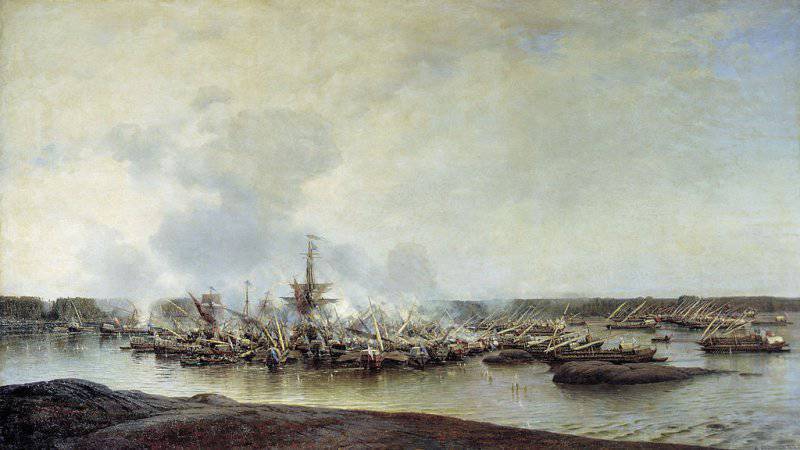
Battle of the Gangute 27 July 1714 of the year. Russian marine painter Alexei Petrovich Bogolyubov
Blockade
The Swedish High Command decided not to allow the Russian troops to use the opportunities that had opened before them with access to the east coast of the Gulf of Bothnia. To do this, it was necessary to block the Russian fleet in the Gulf of Finland, not allowing it to break through to the Abo-Aland skerries, where Russian galleys had an advantage over the sailing Swedish fleet and beyond. In Stockholm they decided to concentrate the main forces of the fleet in the most convenient place for this - near the Gangut Peninsula. The peninsula, located at the mouth of the Gulf of Finland, advanced far into the sea and there were great depths near it that allowed large ships to operate. Before Gangut, Russian ships could move west along the coast, skerries, among the many islands, islets, rocks and straits between them, where the Swedish ship fleet could not attack the Russian galley fleet. But, at Gangut the meeting was inevitable. Here it seemed impossible to slip past the Swedish fleet.
During the 1713 campaign of the year, the Russian command sent captain-commander Matvey Khristoforovich Zmayevich, one of the most experienced commanders of the rowing fleet, to reconnoiter. He had to find the way to Abo, the so-called. "Inner fairway", that is, the closest coast path. However, the Swedish ships already blocked this path. Later, new attempts were made to find a workaround, but they did not lead to luck. As Piotr Alekseevich noted: “... it is impossible to pass by any means from large ships, because for many miles it’s clear and there are no islands anywhere”. The Russian tsar tried to turn for help to the allies, to Denmark, but to no avail. It was necessary to break out of the Gulf of Finland on their own.
The Russian command undertook accelerated measures to increase naval capabilities. In 1713-1714 in Baltic shipyards they laid as many ships as they had never laid here. To strengthen the Baltic Fleet, the entire Russian state was working. At the end of the year, the ships Raphael and Gabriel built in the Arkhangelsk shipyard could break into the Gulf of Finland. From Arkhangelsk arrived and sailors. In addition, Peter bought several ships abroad. In the spring of 1714, 5 ships came to Revel, they were equipped and equipped in Russian ports. At the cost of strenuous efforts, the forces of the fleet have grown considerably. In the spring of the 1714, the Baltic Fleet included the 16 of the battleships (they were inferior to the Swedish ones in seaworthiness and armament), more than the 150 galleys, semi-trailers, scampawas and a large number of auxiliary and transport ships.
In March, 1714, when most of the Gulf of Finland was still icebound, the Swedish fleet left Stockholm and Karlskrona. Squadron commanded Admiral Gustav Vatrang. The junior flagships were Vice-Admiral Lilier, Rear Admirals Erensjold and Taube. The fleet consisted of 16 battleships, 5 frigates and around 10 other ships. In mid-April, the Swedish ships reached the Gangut. First, the ships stopped at Cape Gangut. April 27 on the ship "Bremen" was a military council. It was decided to take a position at the bay Tverminne, which was not far from the isthmus. Here, the width of the peninsula did not exceed 2 versts, and it was possible to build a “perevoloku” for rowing ships, drag them overland. The main forces of the Swedish fleet under the command of Watranga moved to Tverminna Bay, and some of the forces were left to cruise at the entrance to the bay.
However, soon the Swedish command received important information about the serious strengthening of the Russian fleet. As a result, the Swedish commanders decided that Tverminne’s position was removed from the main fairway and inconvenient for intercepting the Russian sailing fleet if it tried to break out of the bay. In addition, the bay worsened fleet maneuverability. The Swedish Military Council decided to return to Cape Gangut.
Gangut battle Engraving of Mauritius Baku
Breakthrough at Cape Gangut
When the Russian fleet was completing preparations for the march, the Russian command decided that the main operational areas would be the Aland Islands. Originally planned to make a decisive attack on Karlskrona or Stockholm, but for this it was required to join forces with the Danish fleet. However, Denmark did not decide on such an operation. Therefore, we decided to limit the final seizure of the Finnish possessions of Sweden.
9 (20) May 1714, the Russian galley fleet under the command of Fyodor Apraksin (about 100 ships with 15-thousand troops) went from St. Petersburg to Kronshlot. Rowing fleet was supposed to land at Abo. In mid-June, the rowing fleet arrived in Helsingfors. The ship fleet under Peter’s command was concentrated in Revel. He had to divert the attention of the Swedish fleet and cover the rowing fleet. 21 Jun Apraksin continued the march and arrived in Tverminn a few days later. For almost a month, opponents watched each other. In late June and early July, Apraksin and Wayde personally conducted reconnaissance from the sea and from the cape. While awaiting Peter's arrival, Apraksin set up surveillance of the enemy, occupied the Gangut Cape with the guards battalions, erected field fortifications there and installed coastal batteries to prevent the landing of the Swedish troops. July 20 arrived Peter. Apraksin offered Tsar Peter several options:
- “rent” the Danish fleet by paying a large sum and by joint efforts of the Russian-Danish fleet to break through the enemy’s battle formations;
- to try to divert the Swedes by the Russian ship fleet by active demonstrations so that the galleys could break through further;
- try to bypass the Swedish fleet during the calm;
- refuse to hike.
Peter decided not to risk sailing fleet to break through the enemy position. As a result, the Russian command decided to create a “perevoloku” in the narrowest part of the isthmus, to build a platform for the transfer of part of the rowing ships by land. This should have embarrassed the Swedes and made them make a mistake, which allowed the main forces to break into the Abo-Aland district. For the device "perevoloki" allocated 1,5 thousand soldiers.
In the meantime, Watrang drew up a plan for the attack of the Russian fleet in Tverminna Bay. He decided to leave several ships off Gangut and to strike the Peter galley fleet with the main forces. However, in the morning of July 25, the Swedish admiral was informed that the Russians were building a “perevoloku” and were going to drag ships by land. This confused the Wattranga, and he began to think about other ways to prevent the Russians. The Swedish admiral decided to divide his forces into three units. Gangut had the 7 of the battleships and the 2 frigate under Watranga. Part of the Swedish squadron under the command of Vice-Admiral Lilier - a strike force from the 8 battleships, 2 bomber ships, went to Tverminna to attack the Russian fleet. The galley squad, commanded by Rear Admiral Niels Erenschold (Erenschild) - the 1 frigate, the 6 galleys and the Scherbot 3, were sent to the north-western gateway to intercept Russian ships at the time of their launching. At noon on July 25, the detachments of Lille and Erenschild performed. Thus, the forces of the Swedish fleet were fragmented, there was a unique opportunity to break the blockade and destroy part of the enemy forces.
The Russian patrol discovered a change and reported on the separation of the enemy fleet. Peter, to study the situation, with a detachment of 20 galleys out of the bay to watch. The king discovered that the Swedish squadron was indeed divided. In addition, there was a calm and completely bound the actions of sailing ships. The Watranga detachment now could not maneuver, and its strength was not enough to cover most of the gulf with naval artillery fire. Swedish ships were stationed at the shore. Peter immediately appreciated the profitability of the moment, the galley fleet was ordered to prepare for a breakthrough.
On the morning of July 26 (August 6), the avant-garde commander Zmaevich of 1714 of the year received an order to “drive around” the enemy. The forward squad had a 20 galleys. It was necessary to bypass the enemy fleet by sea, to reach the skerny region to the north-west of Gangut. To do this, it was necessary to go more than 15 miles at the oars at maximum speed, while being ready to repel the blows of the enemy. Initially, the ships hid the skerries, but then the Swedes discovered them and raised the alarm. Zmaevich successfully passed the position of the Swedes from the sea, followed by the Lefort guards (15 scampaway). Lefort's detachment had to retire a little more into the sea, since the Swedish ships, with the help of towing boats, were able to move a little from the coast. By the 11 clock, both Russian detachments joined and went deep into the Aboski skerries. The unexpected appearance of Russian galleys stunned the Swedes. The Swedes tried to get Russian ships with the help of artillery and bring the ships to the point of breakthrough with the help of lifeboats, but without success. And the detachment Lilye remained only a witness to the breakthrough of the Russian avant-garde.
However, at this time a surprise almost frustrated the plan of the Russian command. When the Russian galleys passed the cape, several Swedish ships came out to meet them. It was Rear Admiral Taube (1 frigate, 5 gallery, 6 Scherbots), which Vatrang summoned from the Aland archipelago to Gangut, to join the main forces of the fleet. The galleries of Zmaevich opened artillery fire on the enemy. But Taube did not accept the fight and turned back. Then the Swedish commander justified himself by saying that "... he was forced to turn back immediately, so as not to be taken." Despite the advantage in artillery weapons, the Taube ships retreated. Taube decided that the whole Russian fleet was in front of him. Although if he started the fight, the situation could seriously change. By noon, the weather began to change. A gentle wind blew. Vatrang raised the signal to the ships Lilje to return to the cape. As a result, the forces of the Swedish fleet were again concentrated. Vatrang built a fleet in two lines. It seemed that this ruled out the possibility of a breakthrough for Russian galleys in the same way. In addition, now the Russian fleet was divided.
Watching the Swedes, the Russians noticed that the enemy had a weak spot. Watrang made a new mistake. The Swedish admiral to quickly connect with Lilye, led his ships to meet him, and opened the way near the coast. Here could go rowing ships that had a small draft. Russian command did not miss this chance. Now it was decided to go for a breakthrough not from the sea, bypassing the enemy fleet, but into the passage between the Vatranga squadron and the coast. At first they wanted to launch an offensive at night, but the coast had a lot of stones and movement at night could lead to serious damage and losses. A breakthrough was scheduled for July 27 morning (August 7).
Early in the morning Apraksin's fleet began to move. The predawn haze hid the movement of the Russian fleet. When the Swedes noticed a breakthrough, they opened fire and some ships tried to bring closer with the help of towing. However, this breakthrough was successful. Only one galley was lost. She came too close to the shore and ran aground. Thus, the main task of the fleet was completed: 98 galleys with 15-thousand. army broke through the Swedish blockade.
The battle with the squad Erensjolda
While the Apraksin galleys were preparing for a breakthrough, Zmaevich discovered the Erenschold squad. The Swedish squad took their position and expected the appearance of the Russians from the land side. However, on July 26, the Swedes heard a cannonade, and then discovered a strong Russian galley squad. Erensjold left the position and tried to leave. But, in a dense labyrinth of skerries, the Swedes got into Rylaksfjord, from which there was no way out. They fell into a trap. Peter, through Adjutant General Yaguzhinsky, offered the Swedes to surrender "without shedding blood." However, Erenskjold rejected this proposal. The Swedish admiral believed in the inaccessibility of his position and expected help from Vatrang or Taube. He wanted to repel the first Russian attacks and gain time, hoping that the Russians, having suffered great losses, would postpone a decisive assault and the detachment would wait for reinforcements.
Ehrenskold arranged his ships in a narrow crescent moon bay on a concave line. The flanks adjoined the coast, in the rear was the island of Shtorin. In the first line in the center stood the 18-gun frigate "Elephant", on the flanks of the 3 galleys (84 guns), in the second line - 3 scherbot (16 guns). Thus, the Swedish commander took a strong position that could not be bypassed, and it was necessary to attack head-on. In addition, the position of the detachment made it possible to use almost all the numerous naval artillery, and at close range, and a gun. The number of Swedish crews reached 941 man with 116 guns.
The Russian ships could not attack with all their might, the place was too narrow. The ships deployed in three lines: the vanguard, the main force and the rearguard. The decisive blow was to deliver the avant-garde. It was divided into three parts: in the center - 11 ships, on the flanks - on the 6 gallery. The main forces were to support the forward detachment as necessary. The starting position was half a mile from the enemy.
In 2 hours they gave a signal to attack. Galleys rushed to the Swedish ships. The Swedes waited and opened deadly fire only at close range - on 300-400 meters. Several dozen guns at close range were shot by Russian galleys. The Russian galleys responded, but their artillery fire power was much inferior. Galleys were small, each had a small gun. Swedish artillery superiority soon affected. The enemy shelling inflicted serious damage on the Russian courts, with each volley the number of dead and wounded grew. Brigadier Volkov, who led the right column, was seriously wounded. Captains Yerofeyev and Poltinin died. The Russian forward detachment was forced to stop and retreat to the starting position. The Swedes repulsed the first attack.
Less than half an hour, as the second attack began. Under heavy enemy fire, the Russian galleys came closer, but after a fierce artillery duel, they were again forced to retreat to their original positions. During the preparation of the third attack, it was decided to abandon the frontal strike throughout the Swedish line. We decided to first focus on the flanks of the Swedish squad.
Around 4 hours began the third attack. The new building reduced the effectiveness of the Swedish artillery fire. Cleverly maneuvering, the Russian ships got close to the enemy. At the start of the 5 hour, several Russian galleries approached the left flank of the enemy line. Galeru "Tranan" was taken to the boarding. As the Swedish galleys approached the deck, the first brave souls rushed, followed by the rest. The onslaught was swift, the crew of the Swedish galleys could not stand hand-to-hand combat and laid down their arms. Behind the first gallery, the rest were captured - Ern, Gripen, Laxen, Geden and Walfish. Both sailors from galleys and soldiers from the Semyonovsky, Nizhny Novgorod, Galitsky, Velikolutsky, Grenadier and other regiments participated in the boarding. Flank ships of the enemy were captured.
However, the Swedes continued to resist. Part of the Swedish crews survived the frigate, strengthening its defense. On the frigate "Elephant" was concentrated the fire of the entire detachment. On the ship fires began and no matter how the Swedes tried to restrain the attack, they did not succeed. Started storming the flagship. The frigate was surrounded on all sides, the Russians climbed on him, and a fierce hand-to-hand fight began. Step by step cramped the Swedes. Soon the frigate was captured. The wounded Erensjold fought to the end and fell overboard, but he was caught. The three-hour battle ended in victory for the Russian fleet.
It was a complete victory: captured 10 enemy ships, 116 guns, the Swedes lost 361 people killed and 580 prisoners. The Russians have lost 127 killed and 342 wounded.

Results
This was the first big success of the Baltic Fleet. In St. Petersburg, solemnly met the heroes of Gangut. Artillery volleys thundered over the city, thousands of people poured onto the embankments of the Neva, meeting the Russian fleet and captured Swedish ships. In honor of the victory, "the headquarters and the chief officers were awarded medals (gold), each according to the proportion of their rank, and the rank and file silver medals and money." Peter I himself received the rank of vice-admiral and "began to sign for receiving 2240 rubles annual salary." Silver medals for awarding the lower ranks were minted according to the weight of ruble players and two varieties: for awarding naval crews and personnel of the landing force.
Gangut victory led to a radical change in the sea. The powerful Swedish fleet, covered with glory of previous victories, suffered a serious defeat from the Baltic Fleet of Russia. The battle showed that the Swedish command underestimated the determination and skill of the Russians, as well as the role of the rowing fleet in the Baltic conditions, and this directly affected the course of the hostilities. Russia had the opportunity to continue the attack on land with the support of the fleet. The Russian fleet could threaten the most important industrial areas of Sweden and attack its sea communications. Already in September, Golovin’s detachment captured Umeå.
The Swedish fleet, which until recently dominated the sea, went on the defensive. The next day after the Gangut battle, the Vatrang fleet was anchored and headed for the Swedish shores, not daring to resist the Russian fleet anymore. Vatrang reported to Stockholm that now the fleet will concentrate all efforts on the defense of the capital. The Taube detachment also retreated from Aland to the Swedish shores, and Russian troops captured the skerries.
Gangut victory made a great impression on the Western powers. Gangut showed that another maritime power was born, which will have to be reckoned with. Britain was particularly alarmed, and it set a course toward neutralizing Russia in the Baltic. The English government, fearing that Russia would force Sweden to capitulate and sharply strengthen its position on the Baltic Sea, began to put pressure on Stockholm to continue the war and threaten the Russian with its powerful fleet. Since the summer of 1715, the British squadron will begin to systematically visit the Baltic Sea, trying to contain the onslaught of Russia on Sweden.
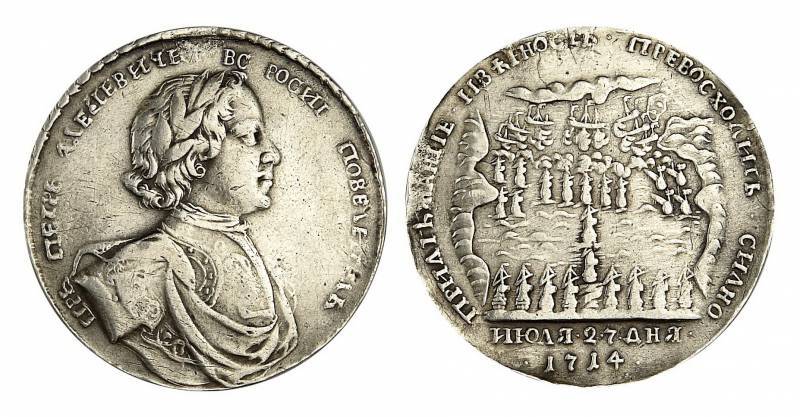
Medal "For Victory at Gangut"
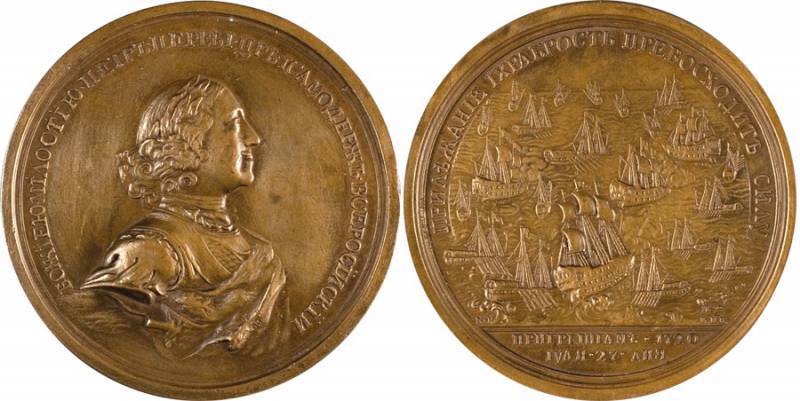
Gold medal with an inscription on the reverse. They were received by assault foremen Peter Lefort and Alexander Volkov, as well as one of the naval commanders, the commander of the galley avant-garde, captain-commander Matvey Zmayevich. The rest went to army colonels and majors, non-commissioned officers, all 144 gold medals and 55 gold chains to them. Army soldiers, ordinary soldiers and sailors were given silver prints with the exact same king on the obverse, a battle scene and an inscription above the date on the reverse: “FITTING AND REALITY EXCELLENT”.
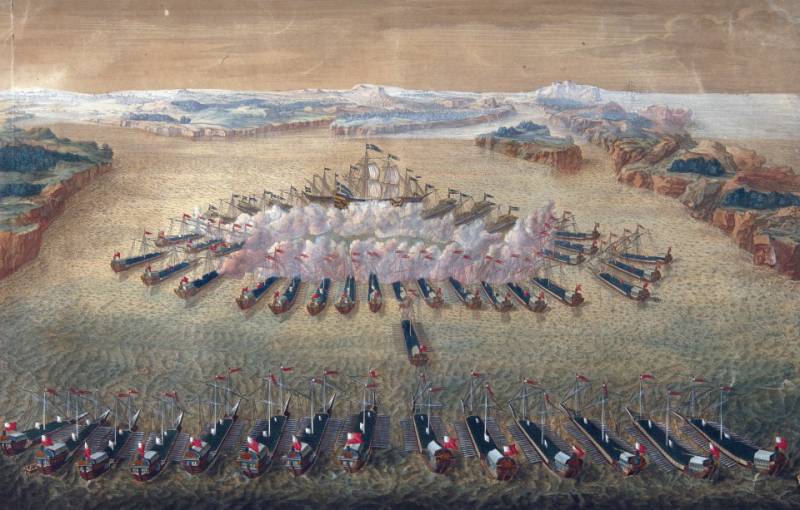
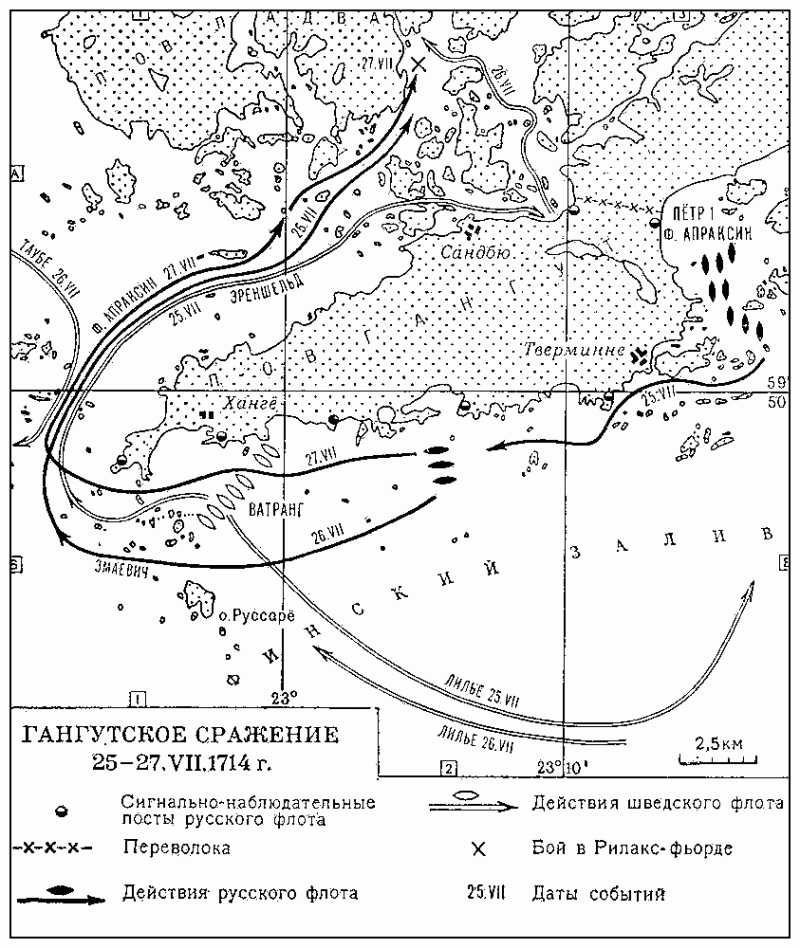
Information